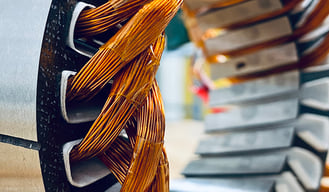 A stator is the stationary component found in electric motors and generators. It consists of a laminated core and coils of insulated wire known as the windings. When alternating current is applied to a stator, it creates a rotating magnetic field.
A stator is the stationary component found in electric motors and generators. It consists of a laminated core and coils of insulated wire known as the windings. When alternating current is applied to a stator, it creates a rotating magnetic field.
CAPABILITIES
Lamination Stacks
Customized lamination stacks (commonly called cores) can be uniquely designed to satisfy customers' requirements by selecting materials, processing, and geometry.
- Manufacturing
- Prototype and low-volume builds are typically produced by using laser/EDM technology, which is a less expensive option for cutting laminations.
- High-volume production typically utilizes the more economical process of stamping for larger volumes.
- Materials
- Motor laminations are made from silicon steels known as electrical steel.
- Silicon steels are used due to their low carbon content which reduces magnetization and high iron content which increases the formability of the material for manufacturing purposes.
- Silicon is added to reduce hysteresis loss significantly. Low hysteresis losses increase efficiencies in electrical machines.
- Common materials used for lamination are M15, M19, and HIPERCO® 50.
- Customization
- Laminations can be built based on the exact specifications of customers.
- Designs can be straight or skewed, with or without end boards, and customized teeth design, and overall geometries.
Insulation
Insulation material is added to separate windings and prevent shorts to the stator core.
- Materials
- Nomex® and Kapton® are commonly used for extra insulation in addition to the enamel on the
copper wire. - Mica
- Mylar
- NKN (Nomex-Kapton-Nomex) material
- NK (Nomex-Kapton) material
- NMN (Nomex-Mylar-Nomex) material
- Teflon
- Nomex® and Kapton® are commonly used for extra insulation in addition to the enamel on the
Coil Winding
Windings are custom inserted by hand into the stators to ensure premium quality and precision fitting per each customer’s specifications.
- Manufacturing
- Coils are produced using customized mandrels to achieve the desired coil pattern per a customer’s specification.
- Coils are automatically wound on a CNC winder for precise control of the number of turns required.
- Materials
- Wire gauges range from 20AWG to 34AWG for most applications. Sizes outside of this range are available as needed.
Both commercial and Mil-Spec grades of wire are available for a wide variety of applications.
- Customization
- Coil wound as concentric, distributed, lap, or custom windings depending on the customer's requirements.
Final Assembly
Finishing operations and testing are customizable to satisfy individual customer specifications.
- Lead Installation
- Custom color codes and wire gauges can be requested. Any additional requirements for electrical connections are accommodated.
- End Turn Forming
- Custom tooling is made to form end turns to be within specification as needed.
- Lacing
- Lacing is added to reinforce the end turns and keep all copper conductors in a compact bundle.
- Varnish Impregnation
- Options for end-turn impregnation include dipping, vacuum, and trickle processes.
- Testing
- Surge tests, hi-pot tests, and electrical characteristics are measured to ensure the stators satisfy the required electrical characteristics. Mechanical inspections are also performed on stators before shipment. Customized data packages can be developed to satisfy unique customer requirements.
.jpg?width=926&height=176&name=eec_cmyk_notag-(maroon).jpg)


.png?width=949&name=eec_cmyk_notag-(white).png)